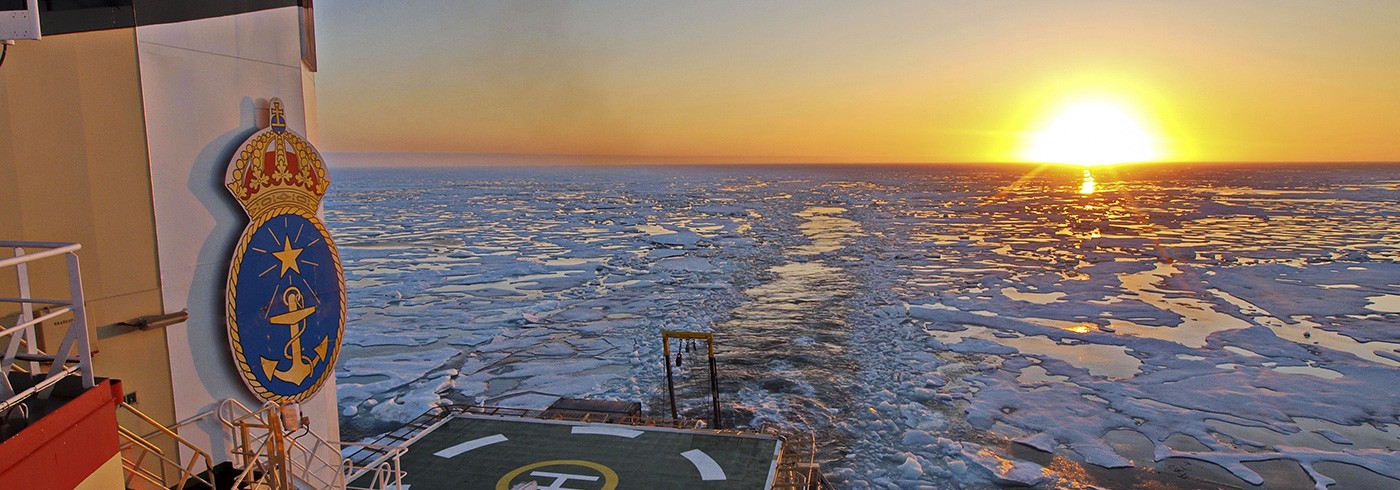All has changed. Once there was open water – now there is ice. We did D to D. We went to Bennett Island to reach E. Sunshine!
We met some ice. Tough ice. Big old ugly floes. There was water so we could sneak around them. There was the island resting in the sunshine. We worked around it. Open water, shallow and no wind. CTD, Multicorer, GoFlo and more of the same. We did Bennett Island. We got to E. Then we started out east. Next was getting to F. Then we met ice. Then came the low clouds. They were added by fog.
We are blind. Guessing around. We were squeezed between the 35 meter depth contour line and huge ice floes. We went down west of a big floe. We had to turn back. Tried to go north and around to the east. No luck we ended up going northwest. Struggling to find a way east. Fog. Decision not to go on guessing and burning expensive valuable fuel. Still over night. Fog all the time. At the 07:00 meeting we decided to try more north and abandon some of the next planned stations. We have some Modis images over our area. They are pretty good. Now we have a two day record of images.
We can now see the ice drift. Plan is to go east and maybe a little north at first. 100Nm. Then south 80Nm. 40Nm longer but at more depth. We do not go more shallow than 50 meters normally. If conditions allow, flat seabed and good data, captain may go as shallow as 35 meters. Icebreaking is an art where mistakes are not allowed. Never get trapped. Going in with the 35 meter depth right on our starboard and huge floes port. Ice drift port to starboard. That’s how to get stuck and pushed to where you don’t want to be.
North and east are better. Solid ice with some leads. But we have fog. How to see the leads? The fog affects even the radar sight. Its view is shortened. Our own eyes see only the mast in the bow. We try short vision driving. But we cannot sit still. That requires patience. Its hard to find patience on board. If you have planned and worked and struggled with planning and preparation for so many years and now we are here. We can’t sit still, we must push forward. We have so many more stations to go.
We go east now. Making progress! Going east and then south makes us miss planned stations. Can we find new sites ad hoc on the way. Corner of east and south direction change could be one. 80Nm with at best 4 knots in the right direction. Two days to get to the next “hot spot” area. The operation in open water, sunshine and no wind was easy. Now we have the opposite. Ice, clouds and fog without wind. In the ice wind is good. It tears the floes apart and get them moving. Something happens. Sometimes it releases the ice pressure, sometimes makes it worse. But something happens. Ice moves easy. It picks up speed from the wind, 3 % of the wind speed and 60 degrees to the right. That’s how ice drift’s. Roughly. Ice moves easy. If there is a high pressure ice will move to the center. If there is a low pressure ice will go away. The high pressure presses the sea surface down and the ice will slide in to the center where it is deepest. In the low it will slide down from the top. The ice has its tricks. It holds us in its grip. Like when the Jeanette was crushed down by ice in 1881. James Gordon Bennett financed the expedition. George Washington De Long led it. We are stronger. Steel not wood. Massive horsepower vs. none. Bennett, Henrietta, Jeanette, Zhokov and Vilkitsky and three more so small they can hardly be seen.
Will we be able to get to F?



